There are 13 different types of frogs in Michigan. Frogs can be found near water and burrowing underground. Heat and moisture are the perfect factors to drive species out from underground. When mating season occurs many species are heard calling from the ponds and water.
You might wonder what frogs inhabit nearby areas and what all of the species in Michigan are. While many look similar there are 13 different kinds to be found in the state, most preferring wet habitats.
In this article, you will find all of the frogs in Michigan and useful information about each one. Frogs and toads look similar but have mild differences. Toads are usually found on land more often and have dry, bumpy skin.
A strong number of frogs and toads in an area is an indication of a healthy environment. Various sizes of species can be found, and some even secrete toxins from their skin. Let’s take a look at all 13 frog and toad species in Michigan.
Table of Contents
Frogs In Michigan
1. American Bullfrog

- Experience Level: Intermediate to Advanced
- Family: Ranidae
- Scientific Name: Lithobates catesbeianus
- Other Names: Rana catesbeiana
- Adult Size: 3.5 to 6 inches
- Lifespan: 7 to 15 years
- Average Price Range: $20
American bullfrogs are large species of frogs that will live in permanent water habitats. They are found all across North America and will inhabit ponds, lakes, swamps, canals, and man-made water sources.
Their large range and size make them a treat eaten across the world.
Breeding for this species will last from May to June in water. The males will call to attract a female or defend their territory. Bullfrogs are aggressive species and will attack and hunt a variety of animals.
The Bullfrog is the largest frog species endemic to North America. Their color ranges from brown to green and they are covered with blotches and spot patterns.
They have large legs, mouths, and eyes. Males will have a yellow throat color and females white. Some will have rough and bumpy backs. Bullfrogs are hunted for their legs but are also preyed upon by larger species like snakes and birds.
Moist and warm weather is what bullfrogs prefer. They will hibernate during the winter and are active the rest of the year. Bullfrogs can be seen in the day or night.
Insects like flies and dragonflies are what they feed on. Crustaceans, salamanders, and even fish will also be eaten by this species.
They are ambush hunters and will wait for prey to come by for hours until they strike.
2. American Toad
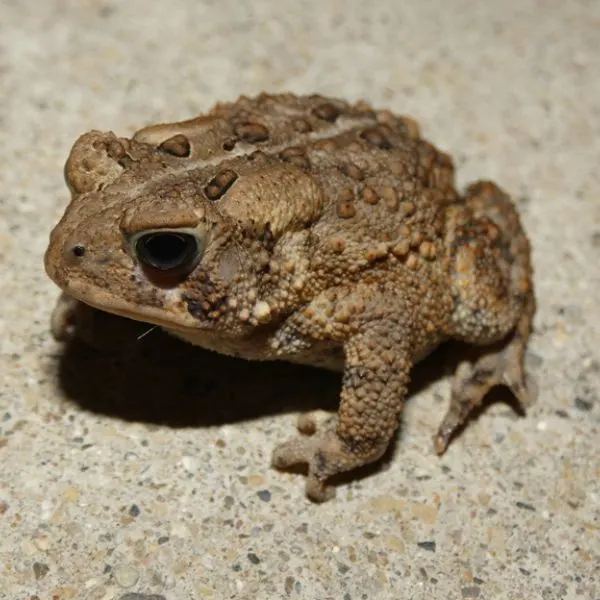
- Experience Level: Beginner
- Family: Bufonidae
- Scientific Name: Anaxyrus americanus
- Other Names: American Toad
- Adult Size: 2 to 3.5 inches
- Lifespan: 2 to 10 years
- Average Price Range: $20 to $30
American toads have a large range in North America and can be found in Michigan. They live in open fields, pastures, forests, and woodlands.
This species is a burrower and will spend periods of its life underground. Sandy loose soil and other moist hiding places for this species are needed for it to be comfortable.
In their burrow is where they will be for most of the day. They are active at night and in summer they will spend most of their time underground to avoid the heat. Spring is when this species will breed and when they will be encountered most.
American toads are medium with brown, gray, or reddish coloring. Their bellies are white or yellow and their shade will vary depending on environment and stress.
Black spots spread across this toad back with one or two warts within each one. Males will have dark chests and females white.
American toads feed on a variety of small insects like earthworms, beetles, ants, and flies. Snakes, birds, and mammals will feed on this species.
The American toad can secrete toxins from its skin but some animals are immune. Their tadpoles will also be eaten by bugs, fish, and some birds. This species is listed as least concern and is able to thrive in many habitats.
3. Cope’s Gray Treefrog
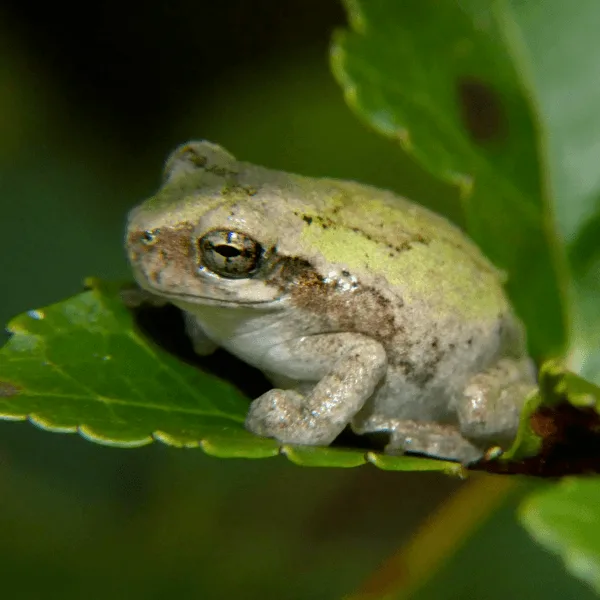
- Experience Level: Beginner
- Family: Hylidae
- Scientific Name: Hyla chrysoscelis
- Other Names: N/A
- Adult Size: 1.25 inches
- Lifespan: 7 to 10 years
- Average Price Range: $20
Cope’s gray treefrog is a type of treefrog that can be found in Michigan forests and woodlands. They are similar to the gray tree frog, and both live within the state.
Cope’s gray tree frog is more arboreal and spends more of its time in trees. Mountain and piedmont habitats are also places to find this species.
In open fields, they may be found when they venture to a water source to mate. Breeding of this species lasts from March to August, and they will lay their eggs in fishless waters.
In winter they will hibernate on the floor, under leaf litter, and in the bark of trees.
Cope’s gray tree frogs have a higher-pitched call and are smaller than gray tree frogs. This tree frog is medium seized with grey to green coloring, and a molted pattern.
Their inner thighs are brightly colored in yellow or orange to startle predators. Males have dark throats and females have white throats.
This tree frog will stay in holes and hide under debris during the day. They will come out at night to hunt for insects and small invertebrates. They find their food in trees and will eat moths, beetles, ants, and other insects.
4. Fowler’s Toad

- Experience Level: Beginner
- Family: Bufonidae
- Scientific Name: Anaxyrus fowleri
- Other Names: Bufo fowleri
- Adult Size: 2 to 3 inches
- Lifespan: 2 to 10 years
- Average Price Range: $20
The Fowler’s toad is native to North America and was previously a subspecies of the Woodhouse toad, but is now its own species.
They live in Michigan and can be found in woodlands, prairies, meadows, and sandy areas. In flowers and vegetable gardens they can be seen foraging.
They are a burrowing species and will be underground when it is hot and dry. They will also stay underground in winter.
Brown, gray, olive green, and rusty red are its possible colors.
Adults are medium-sized with a pale stripe down their back and dark warts covering them. They are capable of secreting toxic compounds from the earth on its back and their bellies are pale.
Birds, large mammals, and snakes prey on the Fowler toad. Small mammals can die from eating them due to the serum they secrete from their skin.
Spiders and small insects are what the Fowler toad eat. Unlike the American toad, they will not eat earthworms.
They take advantage of well-lit areas and light sources to hunt and forage. Breeding sites for this species are common only contaminated and thus some decline of their numbers have been seen.
In some states and areas, they are a protected species.
5. Gray Tree Frog

- Experience Level: Beginner
- Family: Hylidae
- Scientific Name: Dryophytes versicolor
- Other Names: N/A
- Adult Size: 1.25 inches
- Lifespan: 7 to 10 years
- Average Price Range: $20
Gray tree frogs are small tree frog species that enjoy exploring treetops within Michigan.
Gray is its base color but this species uses camouflage and color change to blend into its environment. The gray tree frog lives in highly forested areas with plenty of trees.
When they breed they will go to waters like swamps and semipermanent pools to lay their eggs.
These frogs are heavy-bodied and have black markings on them. Their legs are brightly colored orange to startle enemies. In the trees is where they hang out most, out in high numbers during the breeding period.
Gray tree frogs are nocturnal and during the day will hide under debris and in holes. They hunt at night and eat small insects. The light that attracts insects will also attract frogs to prey on said insects.
6. Green Frog

- Experience Level: Beginner
- Family: Ranidae
- Scientific Name: Lithobates clamitans melanota
- Other Names: Northern green frog
- Adult Size: 2.25 to 3.5 inches
- Lifespan: 15 to 20 years
- Average Price Range: $10
Green frogs can be found in a variety of habitats in Michigan. They require water and will live in ponds, lakes, streams, marshes, rivers, and streams. They can also be found in temporary bodies of water but will not breed in them. Forests and wooded areas with water sources are their preferred living area.
Green frogs are active in the day and on warm nights. In winter they hibernate and lay buried in mud. Breeding occurs in late spring. They mate and breed in permanent waters. These frogs are mainly solitary until breeding season.
Insects like snails, worms, spiders, flies, butterflies, and moths are eaten by this species. They are also large enough to eat some snakes and other frogs. Green frogs are important to the environment and are eaten by birds, snakes, other frogs, and carnivorous animals. They are abundant throughout their range and only face problems with pollution.
7. Western Chorus Frog

- Experience Level: Intermediate
- Family: Hylidae
- Scientific Name: Pseudacris triseriata
- Other Names: Striped chorus frog
- Adult Size: 0.75 to 1.5 inches
- Lifespan: 1 to 4 years
- Average Price Range: N/A
Western Chorus frogs are an abundant species living near Michigan’s water sources.
This species can be found in permanent and semi-permanent water. Swamps, marshes, wet fields, and edges of ponds with high vegetation are their preferred habitat. They are nocturnal, most active on warm summer nights.
These frogs are small, smooth, and can be greenish-gray, red, brown, or olive in color. Brown circular-shaped stripes run down its back and sides.
Small invertebrates and insects are the chorus frogs’ main source of food.
They are secretive but abundant within their range. When frightened they will jump into the water.
8. Mink Frog

- Experience Level: Intermediate
- Family: Ranidae
- Scientific Name: Lithobates septentrionalis
- Other Names: N/A
- Adult Size: 1.9 to 3 inches
- Lifespan: 6 years
- Average Price Range: N/A
Mink frogs are medium-sized species of frogs found in North America and Michigan. They are named for their odd smell, which some say is akin to a mink or onion.
They are green with large eyes atop their heads. Their back is covered with dark blotches and their belly is pale white or yellow.
Mink frogs are highly aquatic and live in water with high vegetation. Ponds, swamps, streams, and marshes are some of the places they live in. Lily pads are common where they live, which they use for basking and feeding.
Spiders, snails, beetles, and other insects are what they feed on.
9. Northern Cricket Frog
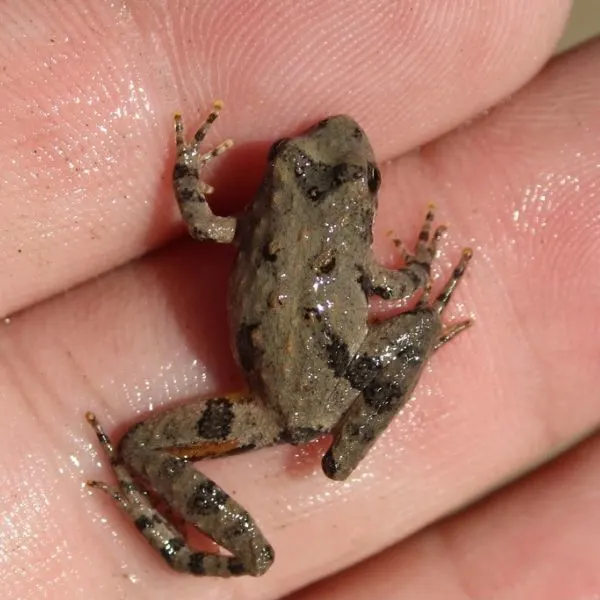
- Experience Level: Beginner
- Family: Hylidae
- Scientific Name: Acris crepitans
- Other Names: N/A
- Adult Size: 0.75 to 1.5 inches
- Lifespan: 10 to 15 years
- Average Price Range: $10 to $20
Northern cricket frogs are found in the United States and Mexico. They can be found in the state of Michigan and will live on the edges of slow-moving and permanent water sources.
Northern cricket frogs are a part of the tree frog family but are not arboreal. They are active during the day and most of the year. They will hibernate mid-winter and will move toward upland habitats.
Northern cricket frogs get together in larger numbers during summer and spring breeding. Males calling will attack others nearby. Insects make up a majority of their diet.
Gray, brown, and green are their most common colors with a light stripe down their back.
10. Northern Leopard Frog
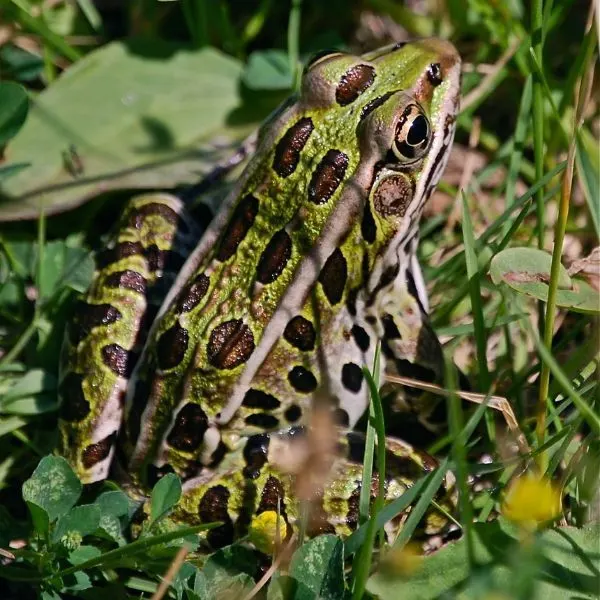
- Experience Level: Beginner
- Family: Ranidae
- Scientific Name: Lithobates pipiens
- Other Names: Rana pipiens
- Adult Size: 3.5 to 4.5 inches
- Lifespan: 2 to 4 years
- Average Price Range: $10 to $15
Northern Leopard Frogs are found all throughout Michigan and have a healthy population. They are also known as grass frogs since they live in highly vegetated areas with plenty of grass.
When breeding they will go near water sources like shallow ponds, swamps, or marshes to find a mate, mostly active at night.
Green, brown, and light tan are their possible colors. Dark spots cover its back and sides surrounded by light edges.
Some frogs will lack the spots on their back but will have them on their legs. Southern leopard frogs do not have white borders around their spots.
If scared, this frog will hop in a zig-zag pattern to escape.
They survive on worms, spiders, and other small insects.
March to May is when the Northern leopard frog begins to breed and their call can be heard from the water. October is the last month of their activity and when they begin to hibernate.
11. Pickerel Frog
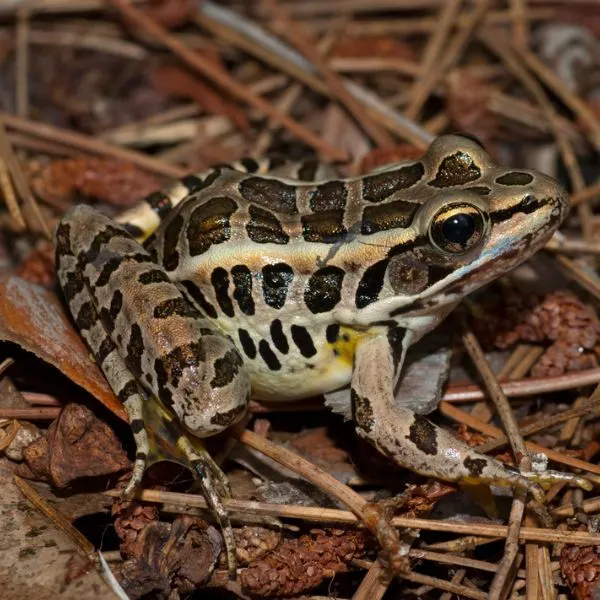
- Experience Level: Intermediate
- Family: Ranidae
- Scientific Name: Lithobates palustris
- Other Names: Rana palustris
- Adult Size: 1.75 to 3 inches
- Lifespan: 5 to 8 years
- Average Price Range: $10 to $15
Pickerel frogs live in freshwater habitats within Michigan. They can live in forests, wetlands, marshes, ponds, and streams.
To breed, they will travel to secluded warm waters. They are active from spring to fall. In spring they breed and males will begin to call from the water at night. In winter they hibernate underground and are buried.
Pickerel frogs look similar to leopard frogs and can be a large species.
They can be brown, tan, gray, or olive green with dark spots on their backs. They have two dorsolateral stripes with a white underside and their legs have yellow or orange coloring between their groin.
Pickerel frogs are the only native frog in North America that is poisonous. Predators will leave this species alone as they secrete toxins from their skin.
Frogs and other snakes are able to eat this species. They will survive off a diet of insects like beetles and spiders.
12. Spring Peeper
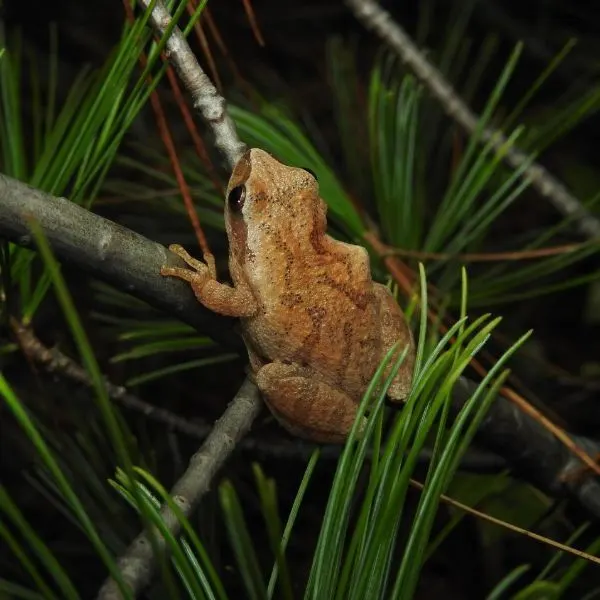
- Experience Level: Intermediate
- Family: Hylidae
- Scientific Name: Pseudacris crucifer
- Other Names: Spring peeper
- Adult Size: 0.75 to 1.25 inches
- Lifespan: 2 to 4 years
- Average Price Range: $10 to $20
The spring peeper is a small chorus frog found in the United States and Michigan. They are one of the first frogs to emerge in spring and their calls will signify the season.
Woodlands and forests are habitats they live in, usually around a water source.
When breeding they will congregate and lay their eggs in marshes, ponds, and as swamps. Males will call with their high-pitched sound from bushes and edges of water.
Spring peepers will lay around 900 eggs in the water. They are the first and last frog to call in the spring.
Spring peepers are small and have a dorsal color of yellow, tan, olive, brown, or gray. Males are smaller and darker compared to females.
Spring peepers will usually have dark bands on their eyes and an X-shaped mark on their back.
This species is common and widespread throughout North America, listed as least concern.
Insects are eaten by this species. They can be seen hunting in the day or night but are more active in the dark.
13. Wood Frog

- Experience Level: Beginner
- Family: Ranidae
- Scientific Name: Lithobates sylvaticus
- Other Names: Rana sylvaticus
- Adult Size: 1.375 to 2.75 inches
- Lifespan: 1 to 3 years
- Average Price Range: $15 to $30
Wood frogs live in Michigan and can be found in forests and woodlands. They will lay their eggs in shallow pools and will generally live around water.
Spring is when mating season begins and males can be heard calling day and night for a female.
Their call sounds similar to the quack of a duck, and they are considered explosive breeders. Leaf litter and under debris are hiding places they hide in.
In winter wood frogs will freeze with special protection in them that prevents their cells from freezing. When they freeze they stop breathing until they thaw in spring.
Brown, red, green, and gray are this species’ possible colors. They have dark markings running across their face which makes it look like they have a mask.
Insects, spiders, worms, and slugs are some of the prey the wood frog will catch with their tongue.
Snakes are this species’ most common predator but they will also get eaten by large birds and mammals. Their eggs are laid and hatched in water.
Tadpoles will be eaten by beetles, frogs, and fish. This species has a stable population but habitat loss can affect them.
Wrapping up
Michigan has 13 frogs that live within the state. Water sources near woodlands, grasslands, mountains, urban areas, and other habitats where frogs can be found. The frogs in Michigan will be fossorial, terrestrial, and even found climbing high in trees. The size, pattern, and location can help identify any amphibians you find.
Frogs and toads are important to the habitats and nature of Michigan. They help control insect populations and are a vital food source for birds, snakes, and other predatory animals. Water is used as a breeding ground and area to lay eggs for frogs. Contamination and destruction of habitat affect many species of amphibians.
Frogs are found everywhere in Michigan even in some residential areas. They can be fun to find in the wild and some species on this list even make great pets. Next time you’re in the wild, maybe you will find one of the 13 species of frogs on this list.
Frogs in other states
